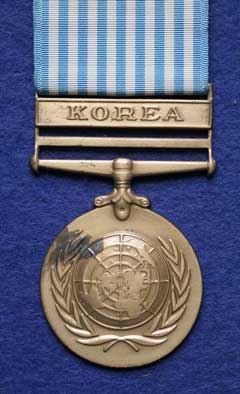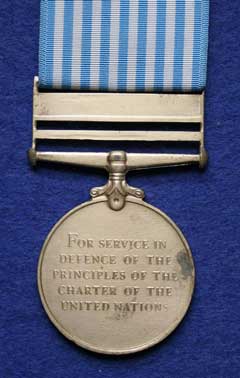MEDAL INFORMATION
UN Medal for Service in Korea (27 Jun
1950 to 24 July 1954)
Face
The emblem of the
United Nations, which is a polar projection map of the world encircled by
two olive branches (the traditional symbol of peace).
Reverse
Plain except for the
inscription: “FOR SERVICE IN DEFENCE OF THE PRINCIPLES OF THE CHARTER OF
THE UNITED NATIONS” in five lines.
Size
Approximately 36 mm in
diameter
Composition
The medal is of bronze
Ribbon
Approximately 34 mm
wide and having nine United Nations blue and eight white stripes all of
equal width, except that the two edge stripes are very slightly wider.
Suspension
A tapered,
non-swivelling suspension bar is fixed to the medal by a claw fitting.
Above this is an unusual type of fitting comprising a straight, narrow
lower bar, a broad middle bar bearing the word ‘KOREA’ and a straight
narrow upper bar. The whole of the suspension is cast in one piece. When
the ribbon is threaded correctly it is passed around the lower straight
bar and both folds pass in front of the upper bar, so that only the
tapered suspension bar and the bar bearing the word “KOREA” are visible.
Naming
This medal was issued
unnamed.
Bars
The medal features an
integral bar bearing the word “KOREA”
Awarded
This medal was
instituted for award to South Korea forces, and to the forces of the
twenty nations which provided active support to South Korea under the flag
of the United Nations. The medal was struck inscribed in twelve different
languages for all the different forces that took part. There were also
variations in the qualifications for the medal, but there was no
restriction as to sex, nationality or rank. The medal was issued to
certain civilian categories who assisted directly, and it was also issued
posthumously. The period of service given as necessary to qualify was a
total of thirty days in Korea or adjacent areas, but for United Kingdom
and Commonwealth troops serving in Korea it was one day on the strength of
a unit. Those on official visits to Korea had to complete a total of
thirty days.
The Korean War resulted from
the crossing of the 38th Parallel and invasion of the Republic of Korea
(South Korea) by the forces of the Democratic Peoples Republic of Korea
(North Korea) on 25th June 1950. The South, which had no air force and
only an untrained and lightly-armed army, was no match for the North,
backed by the Soviet Union, and the United Nations called for the raising
of a multi-national force in support of the South. The force, lead by the
American General Douglas MacArthur, was the first of its kind to operate
under the flag of the United Nations. The British Government, although
initially reluctant to participate, eventually provided a force which was
second only in size to that of the USA among those nations supporting
South Korea, and suffered over one thousand dead and over 2 300 wounded in
the conflict. Although hostilities ceased on 27th July 1953 British
troops serving in Korea in a peace keeping role beyond that date up until
24th July 1954 also qualified for the United Nations medal for Korea.
The
King’s Own
The 1st Battalion The
King’s Own Royal Regiment (Lancaster) did not serve as a unit in the
Korean War, but it provided drafts of men as reinforcements to The Royal
Ulster Rifles, The Gloucestershire Regiment, The Welch Regiment and The
King’s Regiment (Liverpool) which were involved in the fighting. These
men qualified for both the United Nations medal for Korea and the British
Korea Medal. However, the 1st Battalion The King’s Own served as a unit
in a peace keeping role as part of the 29th Commonwealth Infantry Brigade
policing the 38th Parallel following the end of the fighting. The
Battalion arrived in Korea on 7th October 1953 and departed for Hong Kong
on 17 September 1954. All who served with the Battalion during that time
qualified for the United Nations medal for Korea.
United Nations Korea Medals in the museum's collection





